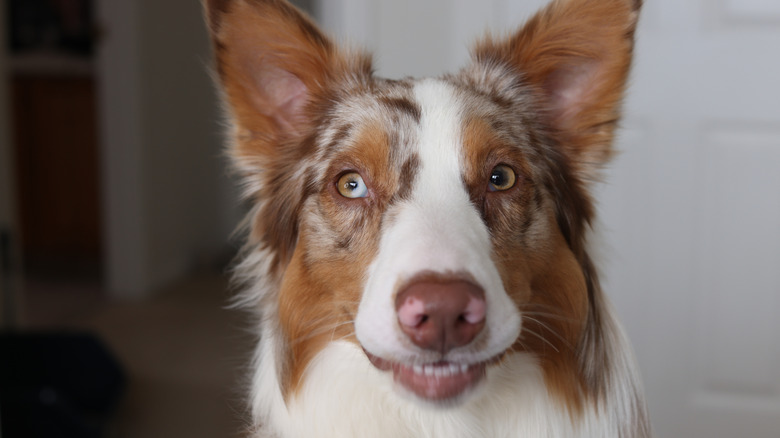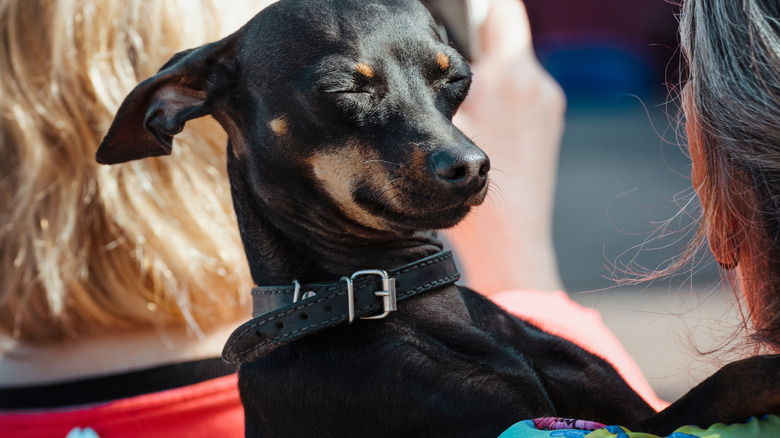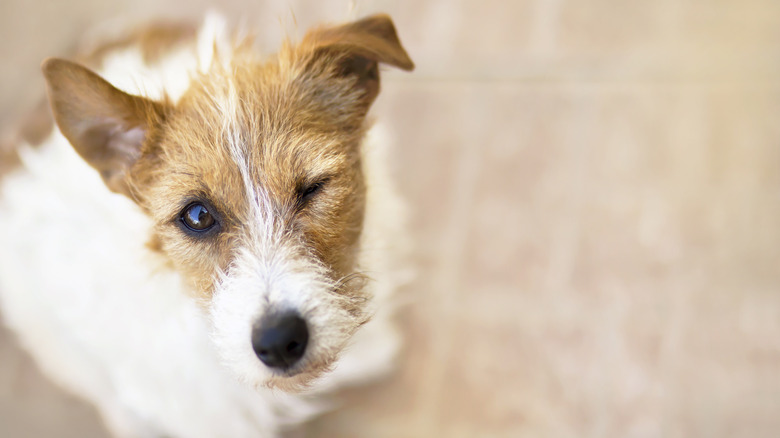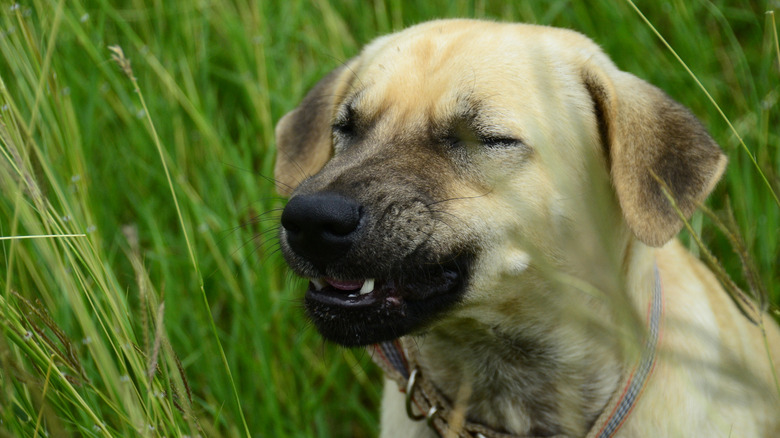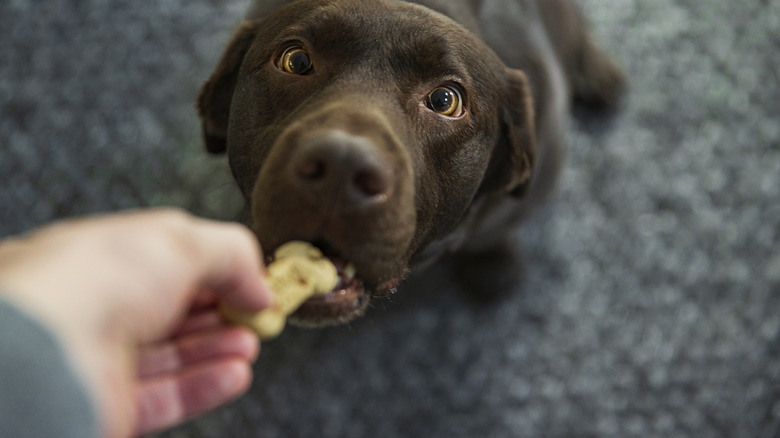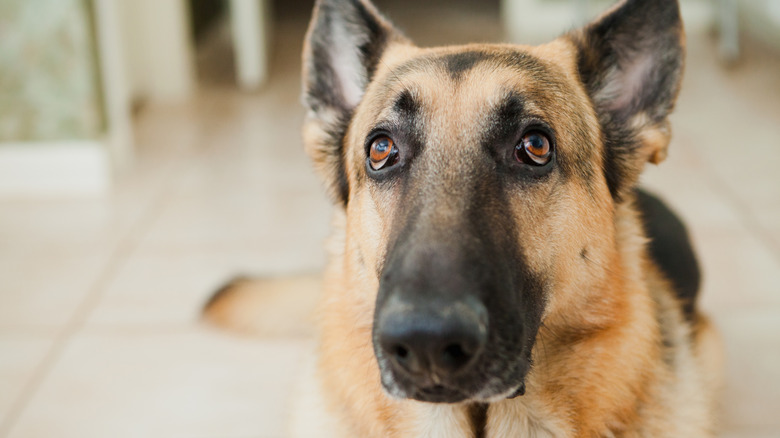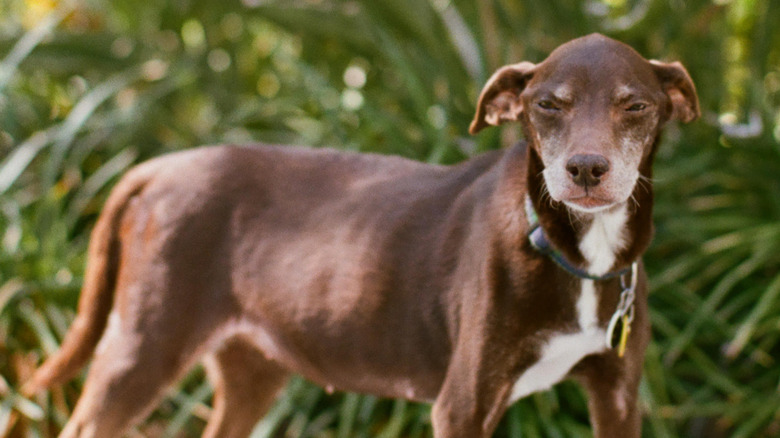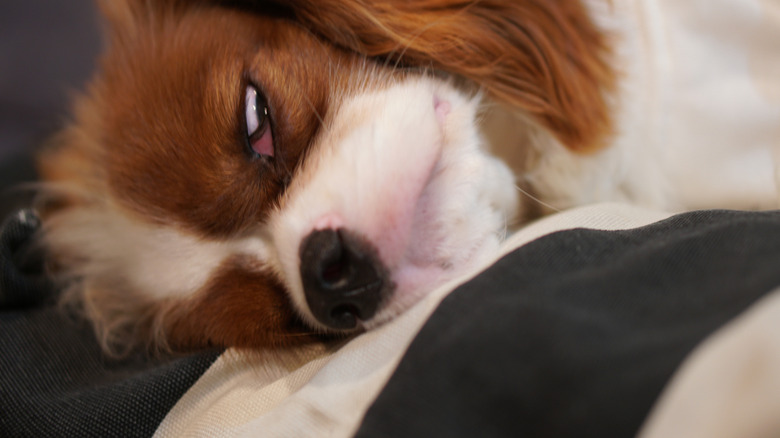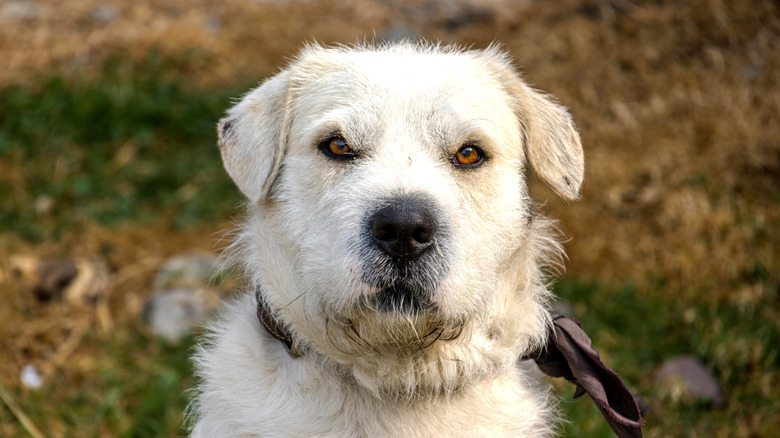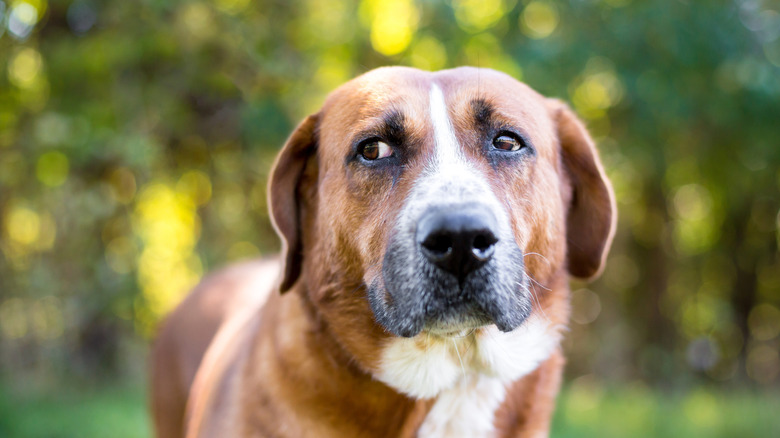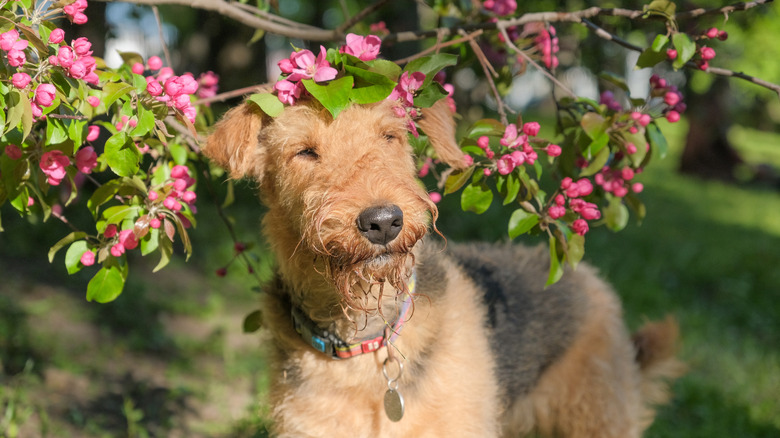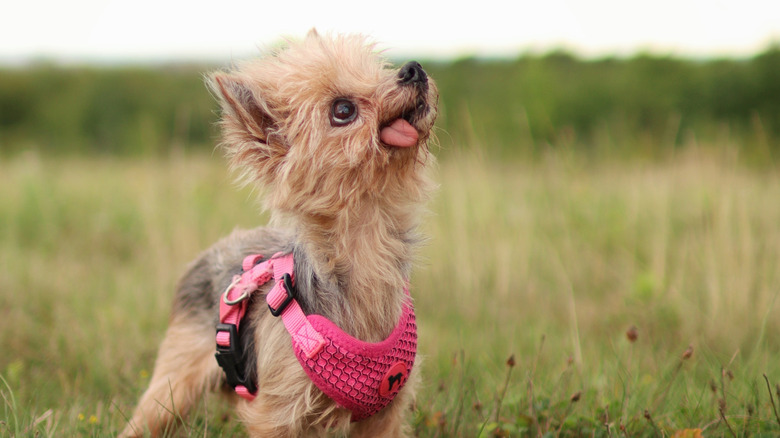12 Facial Expressions Dogs Can Make (And What Each Might Mean)
Every pet parent wishes they could talk to their pup, but many don't realize just how much dogs are able to communicate without words. Facial expressions are one of the primary forms of nonverbal communication dogs use to show their feelings, convey their needs, and ask questions. Learning to understand your canine's facial expressions can even help you spot medical issues before more serious symptoms appear, leading to earlier diagnosis and treatment.
While dogs possess a series of natural facial expressions that trace back to their ancient wolf ancestors, they're also incredibly unique animals in that many more expressions have developed as a part of their more recent evolution as domesticated human companions. Scientific analysis of dogs' facial anatomy published in Biological Sciences shows a muscular structure that has changed to allow movement in ways that people are more likely to understand. An additional 2017 study concluded that dogs change and exaggerate their facial expressions depending on whether or not a human is watching. The next time you catch your canine making a goofy face, there's a good chance they're making it specifically for you.
1. Grinning demurely
Some dogs appear to put on a sheepish smile while welcome their favorite person home or meeting new canine or human friends. This adorable gesture, called submissive grinning in dogs, is much more than a simple greeting. It's actually a defense mechanism canines use to defuse potential aggression from newcomers that likely traces back to their ancient ancestors' behavioral code.
When a dog smiles submissively, their lips may either be closed or open to show their teeth. The latter can feel intimidating to humans who typically associate bared teeth with an aggressive snarl. But it's important to look at the pup's body language as a whole before jumping to conclusions about the intention behind their toothy grin. If a dog shows their teeth while relaxing their posture, closing their eyes or averting their gaze, or lifting a paw delicately, it's almost certainly a submissive gesture. However, visible teeth accompanied by stiff body language or intense staring, is more likely to stem from the dog feeling threatened and warrants caution in continuing to interact with them.
If you're on the receiving end of a submissive grin from your favorite pup, you can likely interpret the behavior as them letting you know they respect your leadership and authority. Grinning from an unfamiliar dog means they'd like to make friends and are hoping to avoid provoking aggression. You can reassure them by lowering yourself towards the ground and giving gentle praise in a soft, soothing voice.
2. Giving a sly wink
If you've ever glanced at your dog and caught them winking in your direction, you might be surprised to learn the behavior could mean exactly what you think it does. Although much of canine body language is misinterpreted by humans, winking is one of a handful of gestures scientists hypothesize dogs may have picked up simply by evolving alongside us for many millennia. Research published in the journal Animals showed that dogs' eyes are cornerstone in their attempts to express themselves and communicate with their human companions. Winking, it seems, is one of many nuanced expressions they've added to their vocabulary.
Your dog might wink at you for a variety of reasons. One possibility is that they've seen you wink in the past and have learned to mimic your behavior. A 2001 study from the Journal of Comparative Psychology demonstrated that dogs are just as adept at interpreting human communication as young children, so seeing you wink at people you like enough times could lead them to repeat the gesture. They might also pick up habitual winking simply to elicit a positive response from you if you've reacted to the adorable gesture in the past.
Occasional winking is a perfectly normal and adorable expression that you're welcome to encourage with as much praise as you see fit. However, persistent winking in the same eye that comes on suddenly is something you'll want your vet to take a look at, particularly if the eye seems irritated. This type of winking, called blepharospasm, can be a sign of a medical issue.
3. Scrunching their nose
Nose scrunching is one of many canine facial expressions that can carry vastly different meanings depending on the context and the accompanying body language. The first and most common cause is sneezing. Dogs are able to sneeze both by blowing air out of their nose like humans and by sucking air in, or reverse sneezing. Your pup may experience this as a result of environmental irritants, allergies, or illness, not unlike the involuntary sneezes you're used to. But canines also sneeze in response to emotionally heightened experiences like playtime or as a way of communicating submission to other dogs.
Further, nose scrunching can be a warning sign that a dog is feeling defensive and may be prepared to act out aggressively. This is most likely to be the case when accompanied by body language such as stiff posture, ears pinned back, raised hair on the back or neck, or direct staring. With this type of nose scrunching, it's best to back away and give the pup space to feel less threatened.
4. Going cross-eyed
Eye crossing is a silly gesture that humans love to use when joking around. Unfortunately, this expression is one dogs aren't able to make intentionally and is most likely to be caused by a medical issue. The rapid onset of crossed eyes could even indicate a health emergency requiring immediate attention from a veterinarian.
Strabismus, the medical term for crossed eyes in dogs, has many potential causes, some of which are more cause for concern than others. Specific breeds, including pugs, Boston terriers, Irish wolfhounds, shar-pei, akitas, and golden retrievers, are more susceptible to developing benign strabismus due to hereditary muscle weakness. Eye crossing that arises slowly and gradually worsens could be a symptom of one of several chronic conditions. It's worth bringing this to your vet's attention to rule out anything that could require treatment.
If your dog's eyes begin to cross suddenly, especially following an injury or when accompanied by other symptoms of illness, it should be treated as a medical emergency. This may be a sign of a more serious problem like head trauma or neurological issues. Set up a vet appointment as soon as possible to get your pup a thorough examination.
5. Raising their eyebrows
Dogs can move their eyebrows in a surprising number of ways. According to the experts, this might be exclusively for your benefit. Scientific analysis of canine facial anatomy has led to the discovery of a large muscle that exists with the sole purpose of controlling eyebrow movement – one that isn't shared with their ancient ancestors. "This muscle is absent in wolves, suggesting that it evolved specifically in domesticated dogs to enhance communication with humans," explains animal behaviorist Hanne Grice.
There are a number of clues indicating why eyebrows have been so important in dogs' evolution over the course of their millennia-long relationship with humans. Eyebrow movement is a major component of nonverbal communication that people rely on to interpret others' emotions. Raised eyebrows in particular seem to elicit a nurturing instinct, a 2019 study suggests.
Research published in PLOS One even showed that dogs with more expressive eyebrows are more likely to be adopted faster from shelters. The fact that canines make these expressions only when they know a person is looking at them further supports the theory that this is nature's way of ensuring they continue to be taken care of by their human companions. In other words, every time your pup sends a heart melting eyebrow waggle in your direction, you're actually getting a peek into natural selection at work.
6. Squinting
Dogs squint for many of the same reasons as humans. On a bright, sunny day, eyes are biologically programmed to squint in order to protect ocular tissues from harmful UV rays. While people tend to throw on a pair of sunglasses for some relief, healthy dogs are unlikely to need protective eyewear unless recommended by a veterinarian. Cumulative sun exposure isn't much of a concern due to their shorter lifespans.
If you notice your dog squinting habitually in dim lighting, however, there might be an underlying issue to investigate. Medical concerns like infections, injuries, and allergies should all be ruled out by a veterinarian. Squinting may also be a symptom of glaucoma, a condition related to eye pressure that also causes discharge and cloudy eyes in dogs and can lead to blindness if not treated promptly. While glaucoma can affect any breed, it's more common in cocker spaniels, basset hounds, chow chows, shar-peis, and huskies.
7. Getting 'demon eyes'
Among dogs' unique physiological features is their third eyelid, a thin membrane that sits on the surface of their eye and closes outward from the inner corner. Though nearly invisible when your pup's eyes are open, the third eyelid serves many important purposes. It helps to protect the eye from irritants, covers a major tear duct, and keeps the eye's surface moist.
In the middle of a deep sleep, your dog's outer eyelids might retract enough to expose the white- or pink-colored third eyelid, giving them a devilish expression. This is no cause for concern. It simply means they're getting some high-quality rest and are feeling extra relaxed.
If the third eyelid becomes visible while your dog is awake, however, they may be suffering from a condition called cherry eye. In cases of cherry eye, the third eyelid typically appears swollen and turns darker red in color. This is most often the result of an issue with the underlying tear gland. Cherry eye frequently requires surgery and should be brought to your veterinarian's attention as soon as possible.
8. Smacking their lips
If you look over to see your dog smacking their lips while you prepare their dinner, it's easy to interpret what their hungry expression means. But dogs perform this action for many more reasons than asking you to hurry up with their food. Lip smacking is an incredibly diverse gesture that can communicate a variety of emotions and needs depending on the context.
Dogs smack their lips when they produce excess saliva, an understandable response to seeing their favorite tasty snack. This also happens due to nausea and could mean they're feeling sick. Lip smacking during a car ride, for example, is a potential warning sign that your pup is experiencing car sickness and could vomit soon. Many illnesses and infections also cause nausea that often presents as lip smacking. These range from parasites and gastritis to chronic liver and kidney disease.
Lip smacking can further be an indication of anxiety in dogs. This is typically accompanied by body language like an averted gaze, yawning, and stiffness. If your pup has a habit of smacking their lips while receiving hugs or wearing costumes, it likely means they're uncomfortable and would prefer to interact with you in less stressful ways.
9. Having a staring contest
In the canine world, direct staring is an unnatural behavior that typically communicates aggressive intentions. Since dogs began to evolve with human companionship, however, staring has become a much more versatile behavior that can also signify trust. To tell the difference, you'll need to evaluate whether the dog in question is familiar to you and look for a few additional context clues.
If a dog you're meeting for the first time is eyeing you intensely, they may be feeling threatened or afraid you might rob them of resources like food or a high-value toy. The best course of action in this scenario is to avert your gaze and move slowly in the opposite direction. This will communicate to them that you don't mean any harm and should quickly deescalate the situation.
However, your own pup staring at you is more likely to mean they want your attention or are trying to tell you something. For example, they may be begging for food you have in your hand or letting you know they need to be let out to use the bathroom. A 2016 study in Biology Letters also showed that dogs have become incredibly adept at reading human emotions, so an unwavering gaze could simply indicate they're trying to connect with you and understand how you're feeling.
10. Giving the side eye
A dog looking to the side is called whale eye due to the large portion of the whites of their eyes showing. When this facial expression is directed towards a person or object, it typically means the pup is feeling anxious or intimidated. The reasoning is that if a dog feels comfortable looking at something, they'll simply turn their head to face it directly. With whale eye, their head is pointed in a different direction, indicating a strong aversion to the subject's presence. However, the perception of a potential threat means they feel unable to take their eyes off of what they fear might pose a danger to them.
If your dog is giving a lot of side eye in an unfamiliar situation, it likely means they're scared or extremely uncomfortable. If possible, try to remove them from the environment or take time to calm and reassure them. Behaviorists also warn that whale eye is a potential cautionary sign that a dog is prepared to act aggressively. When accompanied by additional body language like stiff posture and a wrinkled nose, it's best to keep your distance as a safety measure.
11. Blinking rapidly
Dogs blink much less frequently than humans do – about three to 10 times per minute compared to the human range of 16 to 42 times per minute. With that said, there are a few different reasons you might see your pup start to blink more rapidly. Repeated slow blinking is a sign they're relaxed or sleepy and getting ready for a nice nap. More rapid blinking, however, can be related to multiple causes, some of which require further attention.
Blinking rapidly can be a way for dogs to avoid uncomfortable eye contact with a person or dog they feel intimidated by, indicating submission or anxiety. Try not to force your dog further into an uncomfortable situation when they're displaying this type of facial expression. They might be trying to communicate with you and let you know they're feeling overwhelmed.
Eye irritation is another common cause of rapid blinking in dogs. Conjunctivitis, the type of inflammation humans call pink eye, typically presents in canine subjects as a combination of blinking, swelling, redness, and discharge. More frequent blinking can also be a symptom of blepharitis, or an inflamed eyelid. Whenever blinking is accompanied by additional signs of a potential infection, you should have your veterinarian take a look sooner rather than later.
12. Sticking their tongue out
Dogs stick their tongue out for many different reasons. First and most commonly, there's the obvious tongue lolling that accompanies panting. This is a perfectly normal behavior that your pup uses to regulate their body temperature. Unlike humans, dogs don't have sweat glands and instead use circulating air to cool themselves from the inside out.
Dogs also let their tongues hang out as a characteristic part of a big, happy smile. They use their tongues to taste the air and increase their sensory abilities while sniffing. A pup who sleeps with their tongue out is experiencing deep relaxation, a sign they feel safe and protected in your presence.
Older dogs sometimes experience hanging tongue syndrome, an umbrella term for a tongue that never retracts but hangs out of the mouth permanently. This may be a result of dental decay that comes with poor oral hygiene and age. However, it can be linked to more serious conditions as well. If your dog starts to experience hanging tongue syndrome, your veterinarian may want to conduct a thorough examination to rule out a few causes. Ultimately, they may simply recommend increased access to water a soft food diet. You can avoid hanging tongue syndrome by caring for your dog's teeth with regular brushing from a young age.
